|
|

This chapter describes the CiscoWorks Blue Maps Advanced Peer-to-Peer Networking (APPN) application. It contains the following major sections:
If you prefer to view the APPN information from a web browser, see the chapter "Using the Web Browser."
The APPN application displays a global map of the APPN network topology. The global map is made up of the APPN network nodes (NNs) and the transmission groups (TGs) between them. The network nodes and the transmission groups make up the backbone of the APPN network. From the global map, you can display more detailed maps that show the APPN end nodes (ENs) and low-entry network nodes (LENs) along with the network nodes and the transmission groups.
All APPN network nodes store the same information about the backbone APPN network. At startup, the APPN application must access the network information that is stored in any one APPN network node. APPN needs the information from the APPN Management Information Base (MIB) before it can display an APPN map. The network node that supplies this network information is called the network topology agent.
APPN network nodes are named in the format NETID.CPNAME, rather than by IP address or device name. For example, a node with NETID=NETA and CPNAME=IBUPU3 would be displayed as NETA.IBUPU3.
However, the APPN application needs IP addresses or device names so that it can manage the APPN routers using SNMP. APPN uses its discovery process to correlate the APPN names with the IP addresses or device names.
You can start the APPN application from the workstation system prompt, from a remote workstation, or from a network management system, such as NetView for AIX. Before you can display APPN resources, you must have access to a network topology agent that collects and stores the information. A network topology agent is an APPN network node that provides information about the backbone APPN network. You can specify a network topology agent in one of the following ways:
The installation process establishes a sample default user account named cwblue. The user cwblue does not have a starting password. The user cwblue does not have a starting password. You can either assign a password to cwblue or log in as root and change to cwblue. Then start the APPN application.
To start the APPN Maps application from a workstation system prompt, enter these commands:
cd install_directory/appn/bin
runappn [-f devicename [-r read_community_string]] [-v]
Where:
install_directory is the directory in which Maps is installed, usually /usr/cw-blue for AIX or /opt/CSCOcb for HP-UX and Solaris.
-f devicename specifies the host name or IP address of an APPN node to be used as the network topology agent.
-r read_community_string specifies the read community string for the router specified by devicename. APPN uses the read_community_string value when communicating with an APPN node. If you do not enter a read community string, the APPN application uses the default read community string specified in the cwbinit file or, if there is not one there, the default string "public."
-v displays version information.
You can log in to a remote UNIX host from your own local UNIX workstation, export the remote host display to your local workstation, and then run the application from the remote host. To start the remote host's APPN application from your local workstation, use the following procedure:
Step 1 At your local UNIX workstation, enter the following command:
xhost +
Step 2 Log in to the remote UNIX host as cwblue (or with a username of your own choosing).
Step 3 Set your DISPLAY environment variable to export the display from the remote host to your local workstation. Depending on which shell you are using, use one of these commands:
From the K shell (ksh):
export DISPLAY=IP_address:0.0
From the C shell (csh) or TC shell (tcsh):
setenv DISPLAY IP_address:0.0
Step 4 To start APPN, enter the following commands:
cd $CWBROOT/appn/bin
source runappn [-f devicename [-r read_community_string]] [-v]
Where:
-f devicename specifies the host name or IP address of an APPN node to be used as the network topology agent. APPN displays a global view at startup.
-r read_community_string specifies the read community string for the router specified by devicename. APPN uses the read_community_string value when communicating with APPN nodes. If you do not enter this value, the program uses the default read community string "public," unless another default string is specified in the cwbinit file.
-v displays version information.
If you start APPN from NetView, or if you do not enter any options with the runappn command, the APPN application looks in its preferences file, $CWBROOT/etc/cwbinit, for the control point (CP) name, or for an IP address or device name (and read community string) of a network topology agent. If a network topology agent is not specified in the cwbinit file, APPN displays the APPN Startup Query window, shown in Figure 7-1, which prompts you to identify a network topology agent.

Use the APPN Startup Query window to select a network node to be the APPN topology agent.
This section describes how you select a network topology agent, which is an APPN network node that provides information about the backbone APPN network.
When you first start APPN, you select a network topology agent by its host name or IP address and its read community string. Enter the device name or IP address in the "Device Name:" field, and enter the read community string in the "Read Community:" field. The device name and read community string are both case-sensitive. Click OK.
If the APPN application has already learned the IP address or device name and the read community string of the network topology agent, you can enter just the network topology agent's control point (CP) name. In the "APPN CP Name:" field, enter the CP name of a network topology agent and click OK.
You can discover a network topology agent even though you do not know the host name, IP address, or CP name. Click Discover (option) and then use the following procedure:
Step 1 Select either Database or Seed File in the "Source" field.
If you select the Database option, APPN uses the network management system database to get a list of devices to discover.
If you select the Seed File option, APPN prompts you to enter the name of a Maps seed file.
Step 2 In the "Method" field, select either Discover One to discover just one network topology agent, or select Discover All to discover all APPN network topology agents. This discovery also saves the correlation between each device's IP address and CP name.
Step 3 Click OK.
Maps also provides a version of the APPN application called the APPN poller. The APPN poller monitors the APPN network to generate event notifications for status changes, as defined in the cwbinit file. You start the APPN poller from the command line; it does not have a graphical user interface.
To start the APPN poller from a workstation system prompt, enter the following commands:
% cd install_directory/appn/bin
% runappnpoller [-f devicename [-r read_community_string]] [-v]
Where:
install_directory is the directory in which Maps is installed, usually /usr/cw-blue for AIX or /opt/CSCOcb for HP-UX and Solaris.
-f devicename specifies the host name or IP address of an APPN node to be used as the network topology agent. You must identify a network topology agent either with this option or in the cwbinit file. If you do not specify a network topology agent in one of these ways, the APPN poller will terminate.
-r read_community_string specifies the read community string for the router specified by devicename. APPN uses the read_community_string value when communicating with an APPN node. If you do not enter a read community string, the APPN application uses the default read community string specified in the cwbinit file or, if there is not one there, the default string "public."
-v displays version information.
The APPN poller application starts a background process called appnpoller. To verify that the APPN poller is running, enter the following command:
% ps -ef | grep appnpoller
This section describes the APPN discovery process and includes the following sections:
The APPN application performs several kinds of discovery:
APPN identifies nodes using their APPN names, which are in the form NETID.CPNAME. NETID is the network ID; CPNAME is the control point name. To query and collect management data from nodes, APPN must also know the IP address for each node (because the APPN application manages APPN nodes using the SNMP protocol).
The process of finding an IP address for each APPN node is called discovery. APPN starts with the APPN CP name for each node. Then it discovers the IP address by prompting you to enter an IP address or device name (and read community string) for each CP name the first time that you request a view. The APPN application maintains this correlation between IP address and CP name for subsequent sessions.
To avoid being prompted for IP addresses or host names, you can perform a one-time discovery of the entire APPN network. For APPN, this discovery is the process of querying all IP devices in the network to determine whether they are also APPN network nodes, and, if so, to get their APPN names.
The APPN application stores the correlation data in a binary file named
$CWBROOT/etc/appnfile. You should not edit this file, but you can delete it to force the APPN application to lose all its correlation data and rediscover the network. You can delete this file to force rediscovery when CP names or IP addresses are changed or reassigned.
You can launch the discovery process either from the APPN Startup Query window or from the Discover item on the Admin menu.
We recommend that you not launch the discovery process using a network management system, because the network management system selects a topology agent at random. It is better to either explicitly select a topology agent or to use a seed file of network nodes from which to select a network topology agent. APPN queries the devices from the seed file in the order in which they are listed. You can launch discovery using a network management system to correlate the IP addresses with CP names for the remaining nodes.
When you first launch APPN using the runappn command with no options, the APPN Startup Query window asks you to either identify a network topology agent or start the discovery process. If you choose to start the discovery process, you then must make the following decisions:
You can launch the discovery process from the Admin menu in two ways.
This process discovers all the devices in the seed file or database. After discovery is complete, select View>Global to display the global view with the network topology agent.
Each record in the seed file can be a comment or a router specification. You can list the routers in any order within the seed file, but the order of routers in the seed file determines the order in which the routers are discovered to select a network topology agent.
A comment is a single line of text that begins with the # character, as follows:
# This line is a comment.
A router specification has one of the following formats:
router [read_community_string]
or
router:[read_community_string]
Use the following conventions for the router specification:
The delimiter can be a space or a colon (:).
router can be either a host name or an IP address of a router in the network.
read_community_string is the read community string for that router. To use the default string (public), you can omit the read_community_string or you can use just an asterisk (*) as a place holder for the default read community string. If a read community string is missing for a device, the APPN application uses the default read community string specified by the rdcommstr parameter in the cwbinit file. You can create the APPN seed file with a text editor, and then save it as the appnseed file. The recommended location for the seed file is $HOME/.appn/appnseed.
You can use the same seed file for all three Maps applications (DLSw, RSRB, and APPN). Although DLSw has a third parameter on each router entry to identify a router as a key device, that parameter is ignored for the APPN and RSRB applications. The following lines are from a sample seed file:
# Seed file for CiscoWorks Blue Maps applications
# Next is a non-key router with goldilocks read community string
east.cisco.com goldilocks
# Next is a non-key router with default read community string
172.18.7.47
# Next is a key router with default read community string
west.cisco.com:*:key
# Next is a key router with a read community string
east.cisco.com:readstring:key
To use a seed file to provide the information to the application, use the following procedure:
Step 1 Use a text editor to create the seed file. Save the seed file, for example with the name $HOME/.appn/appnseed.
Step 2 Start APPN and select Admin>Discover>Seed File. to display the Seed File Discover window.
Step 3 Enter the name of the seed file, verify the correct read community string, and click Discover. Discovery takes place while you wait.
Step 4 After loading the database using the seed file, the application operates accurately until a router is taken off line or a new router is configured. At that time, you can do one of the following actions:
The cwbinit file contains a set of startup options and variables for the APPN application. However, if you start APPN with command-line options, the command-line options override the options set in the cwbinit file.
These APPN parameters in the cwbinit file are used only when you start runappn or runappnpoller. If you change the cwbinit file while the APPN application is running, you must stop and restart the APPN application to enable the changes to cwbinit.
Use the kill command to stop the APPN poller application. Then restart the APPN poller application using the following command:
% $CWBROOT/appn/bin/runappnpoller
To reset the APPN application, select File>Exit Program from the APPN menu bar. Then restart the APPN application using the following command:.
% $CWBROOT/appn/bin/runappn
For each variable that you set in cwbinit, ensure that there is a space before and after the equal sign. For example, to turn off the eventgen variable, you would enter the following line in cwbinit:
eventgen = off
Each APPN user can have a private cwbinit file. If the APPN application cannot find the file $HOME/.cwbinit, it uses the file $CWBROOT/etc/cwbinit.
The following file is the sample cwbinit file stored during installation of
CiscoWorks Blue Maps.
# Cisco Works Blue Maps preferences file
# (comments start with # in column 1 and blank lines are OK)
# (keywords must start in column 1, and there must be
# a blank on each side of the = character)
# These parameters are only read at startup time by the DLSw poller and
# APPN applications. See the DLSw or APPN parameters section for details.
# *************************
# *** Global parameters ***
# *************************
# to turn off event generation set eventgen = off.
# valid values : on/off. default value : on.
eventgen = on
# to turn on device state change event generation set eventgen_device = on.
# valid values : on/off. default value : off.
eventgen_device = off
.
.[DLSw parameters removed]
.
# ***********************
# *** APPN parameters ***
# ***********************
# These parameters are used by both appn and appnpoller. If either
# are already running, they must be stopped and restarted for changes
# to take effect. appnpoller can only be stopped with the kill command.
# Restart appn with the $CWBROOT/appn/bin/runappn script, and appnpoller
# with the $CWBROOT/appn/bin/runappnpoller script.
# Selection of the network topology agent is done in this order:
# 1) command line parameters, if any;
# 2) parse the config file.
# 3) user will be prompted to run discovery or enter agent information
# network topology agent ip address or device name (NOT appn cpname)
nettopoagentdevname =
# network topology agent read community string
nettopordcommstr =
# network topology agent APPN control point name (NETID.CPNAME format)
nettopoagentcpname =
# backup network topology agent ip address or device name (NOT appn cpname)
backupnettopoagentdevname =
# backup network topology agent read community string
backupnettopordcommstr =
# backup network topology agent APPN control point name (NETID.CPNAME format)
backupnettopoagentcpname =
# default read community string
rdcommstr = public
# automatic collection of local topology (NONE, NN_ONLY, ALL)
autolocaltopo = NN_ONLY
# network topology polling interval, in seconds
nettopopoll = 15
# backup network topology polling interval, in seconds
# (in backup mode only, when primary agent fails, backup uses nettopopoll)
backupnettopopoll = 600
# local topology polling interval, in seconds
loctopopoll = 600
# control whether appn polls the DLUR PU table as part of local topology
# polling. To turn off polling for PUs, set appn_pu_polling = off
appn_pu_polling = on
# to turn off tg event generation set eventgen_tg = off
# valid values : on/off
eventgen_tg = on
# to turn off dlur session event generation set eventgen_dlur = off
# valid values : on/off
eventgen_dlur = on
# to turn on port event generation set eventgen_port = on
# valid values : on/off
eventgen_port = off
# to turn on link event generation set eventgen_link = on
# valid values : on/off
eventgen_link = off
If you would rather not use the APPN Startup Query window, you can use the cwbinit file to specify a topology agent in one of the following ways:
If you specify a network topology agent in the cwbinit file, you can also specify a backup network topology agent in the cwbinit file. Specify the backup network topology agent in one of the following ways:
If you do not specify a network topology agent in the cwbinit file or as a command-line parameter, the APPN application displays the APPN Startup Query window to prompt you to identify a network topology agent. If APPN cannot collect network topology from the agent you identify, it tries again using the interval specified by the nettopopoll variable in the cwbinit file.
Network topology polling is the periodic collecting of data from the network topology agent. Local topology polling is the periodic collecting of data from each APPN node.
Because the overhead of network topology polling is less than the overhead of local topology polling, the APPN application performs network topology polling more frequently than local topology polling. To control the frequency of polling, use the nettopopoll, loctopopoll, and backupnettopopoll parameters in the cwbinit file.
You can use the appn_pu_polling parameter to control polling for PU information. If you set appn_pu_polling = on, APPN polls for PU information at the interval specified by the loctopopoll parameter. The appn_pu_polling parameter affects polling only; it does not affect the collecting of local topology when you select Get Local Topology from a popup menu.
The APPN application collects and stores local topology data collected from an APPN node. The APPN application usually collects local topology data on demand, such as when the generation of a view requires it. To expedite the generation of some views, and to assure the completeness of adjacent-node views, set the autolocaltopo parameter to one of the following values:
ALL automatically polls local topology data from all APPN nodes for which SNMP information is already available at the interval specified by the loctopopoll parameter in the cwbinit file.
NN_ONLY automatically polls local topology data only from network nodes for which SNMP information is already available at the interval specified by the loctopopoll parameter in the cwbinit file. NN_ONLY is the default.
NONE does not poll local topology data automatically.
You can configure the APPN application to generate event notifications (trap messages) when specific network events occur. These network events can include changes to a transmission group's state, changes to a DLUS-DLUR session state, and changes to the status of a node, a port, or a link. When the specified network event occurs, APPN sends a trap message to the network management system.
Use the following event values in the cwbinit file to specify whether to send event notifications and to specify which events will cause trap messages to be sent.
After you configure the event notification options, APPN will send trap messages to the network management system at your UNIX workstation. The chapter "Event Notification Messages" lists the trap messages sent by the Maps applications.
This section describes how to locate and select nodes on the APPN map.
There are two methods for locating a node on the APPN map:
To locate a node from the View menu you must know the node's CP name, IP address, or host name. Then use the following procedure:
Step 1 Select View>Locate from the APPN menu bar.
Step 2 Select either By CP Name or By IP Address or Device Name.
Step 3 Enter the CP name, IP address, or host name of an APPN node.
Step 4 Click Locate.
APPN displays the portion of the map that contains the selected device and highlights the device.
To use the Locator window to locate a device on the APPN map, select Option>Show Locator from the APPN menu bar to display the Locator window. The Locator window contains a miniature representation of the entire network. The area of the Locator window that is within a black frame is the area of the network that is actually displayed in the main window. You can move the frame in one of the following ways:
As you move the frame in the Locator window, look for the device you want in the main window. When you find the device, you can display the focus view, peer statistics, or circuits for that router, or use one of the other Maps functions.
Each icon on the APPN map has an associated popup menu. To activate the menu, click the icon with the right mouse button. Table 7-1 lists the popup menus associated with the APPN map icons.
| Icon | Popup Menu Items |
|---|---|
Information---Displays information about the selected node, including the device type, the node type, and the node's capability information. List LUs---Lists the LUs associated with the selected node.
Get Directory---Queries the selected node to compile a directory of LUs. Show Adjacent Nodes---Displays the nodes adjacent to the selected node. Telnet---Starts a Telnet client. | |
Port Info---Displays information about the selected port, including the port name and status, the data-link control type, and the MAC and SAP addresses. | |
Link Info---Displays information about the selected link, including the link name, CP names at either end of the link, link addresses, and link capacities. | |
Virtual Routing Node | Information---Displays information about the selected node, including the device and node types, and capability information. Show Adjacent Nodes---Displays the nodes adjacent to the selected node. Telnet---Starts a Telnet client. |
The APPN map presents a global (high-level) view of the applicable network devices and an up-to-date view of the APPN-enabled network nodes and their status and the transmission groups that connect them. From the APPN menu bar, select View to display the available views of the network map. You can display the following views:
Global view, as described in the section "Displaying the Global View of the Network."
Adjacent nodes view, as described in the section "Viewing Adjacent Nodes."
Ports and links view, as described in the section "Viewing Ports and Links."
When you select the global view, the Locator window displays the entire network while the main window displays as much of the network as will fit in a magnified format, which may be the entire network or a subset of the network. The global view is displayed when you start the APPN application. To display the global view at another time, select View>Global from the APPN menu bar. The global view is displayed, as shown in Figure 7-2. You can move the black frame in the Locator window to change the view in the main window.
The global view displays devices and connections from the APPN network topology database as viewed from the network topology agent. The global view shows the network nodes and virtual routing nodes and the transmission groups (TGs) between them. The TGs are aggregated so that one line between two nodes represents one or more TGs between the nodes.
If a node has unknown status, APPN has determined that the network topology agent is not getting updates about that node. This problem may be caused by inactive TGs or no CP-CP sessions to carry the updates.
The global view is updated as new information is available from the network topology agent, subject to the polling interval (defined by the nettopopoll parameter in the cwbinit file).
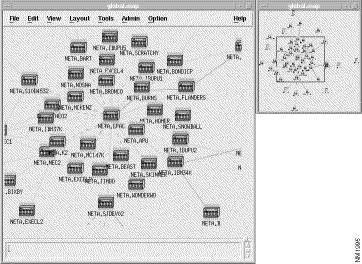
To view information about the connections between the nodes, use the following procedure from the global view (which is shown in Figure 7-2):
Step 1 From the APPN global view, point to a TG (the line that connects the two nodes).
Step 2 Press the right mouse button.
Step 3 Select one of the following items from the popup menu:
Aggregate TG Info displays information about the aggregated TG.
List TGs and Links displays a list of the individual TGs and links that are represented by the aggregated TG. The list of links in the lower part of the window is associated with the TG that is highlighted in the upper part of the window.
Step 4 Select Info from the popup menu to display details about the TG or link that you selected.
To view network node information, use the following procedure:
Step 1 Point to a node.
Step 2 Press the right mouse button.
Step 3 Select Information.
APPN displays information about that node, including its CP name, device type, and node type, as shown in Figure 7-3.
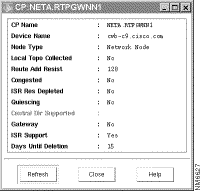
To view the supported LUs, you must first collect directory information from the network. Use the following procedure to collect directory information and display LUs.
Step 1 Select a network node.
Step 2 Press the right mouse button.
Step 3 Select Get Directory from the popup menu.
Step 4 Press the right mouse button again.
Step 5 Select List LUs from the popup menu. The List LUs window displays a list of LU names that are supported by the selected network node. For each LU in the list, APPN displays the control point where the LU resides, the network node server, and the LU's directory type.
To view adjacent nodes, use the following procedure:
Step 1 From the APPN global view, point to a node.
Step 2 Press the right mouse button.
Step 3 Select Show Adjacent Nodes.
The adjacent nodes view shows a subset of the APPN network that includes the following nodes:
To ensure the generation of complete adjacent nodes views, see the section "Using cwbinit to Facilitate the Generation of Views."
To view the ports and links information, use the following procedure:
Step 1 Point to a node.
Step 2 Press the right mouse button.
Step 3 Select Ports and Links.
The ports and links view, shown in Figure 7-4, is a view of all the logical ports on the selected node and the links from those ports to adjacent nodes. Each adjacent node is displayed with its network ID (NETID) and control point name (CPNAME) in the format NETID.CPNAME.

If there is an inactive link and the node does not have the adjacent CP name defined, APPN displays the node with the text "link=linkname" in place of the node's APPN name, as shown in Figure 7-5.

This label indicates that the link is inactive and the destination node of the link is not known to the selected APPN node.
The ? indicates that the node's name is also not known. The text "link=linkname" indicates the link between the known APPN node and the unknown node.
The ports and links view can depict the following port types:
To display detailed information about a port on a network node, use the following procedure:
Step 1 From the ports and links view, select a port icon.
Step 2 Press the right mouse button.
Step 3 Select Port Info.
The APPN application displays the port information window, shown in Figure 7-6, which includes the port name, port state, data-link control (DLC) type, and line type.
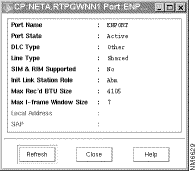
To display detailed information about link, use the following procedure:
Step 1 From the ports and links view, select a link icon.
Step 2 Press the right mouse button.
Step 3 Select Link Info.
The APPN application displays the Link Information window, as shown in Figure 7-7.
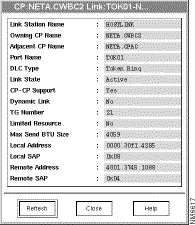
This section describes how to use the Tools menu to view PUs and LUs in the APPN network.
The APPN application does not use SNA View to correlate PU and LU information. Instead, APPN collects the PU information from the DLUR MIB on the router, and it collects LU information from the directory table in the APPN MIB.
You can select Tools>PU from the menu bar to configure filtering criteria for use in searching the database for PUs. To locate PUs from the Tools menu, use the following procedure:
Step 1 From the Map application's menu bar, select Tools>PU. The PU Filter window is displayed, as shown in Figure 7-8.
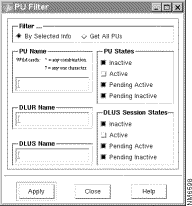
Step 2 In the PU Filter window, select the method for filtering the PU names to get the PUs you want to view:
By Selected Info filters the list based on the PU name, Dependent LU Requester (DLUR) name, Dependent LU Server (DLUS) name, PU state, and DLUR------DLUS session state. For more information about filtering PUs, see the section "Filtering the PU List."
Get all PUs creates a list of all PUs in the domain.
Step 3 Click Apply. The PU List window is displayed, showing the PU names, filtered as you requested. The PU List window is shown in Figure 7-9.
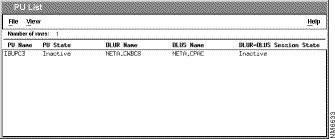 U List Window
U List Window
The PU List window displays the DLUR name, the DLUS name, and the DLUR-DLUS session state for each PU.
When you select Tools>PU from the menu bar, the APPN application displays the PU Filter window to let you configure a filter for use in selecting the PUs to display. You can get all PUs, or you can configure the filter to select PUs based on applied criteria. You can filter the names in the PU List based on the PU name, DLUR name, DLUS name, PU state, and DLUR-DLUS session state.
To display all PUs, select Get All PUs to display a PU List that contains all PU names in the network.
To display PUs based on their PU names, enter all or part of a PU name in the form NAME. (Because SNA View is not used, the PU name does not include a domain name.) You can use a wildcard, such as PU*, to display a list of PU names that all begin with the same characters. The PU List will contain PUs whose PU names match the filter criteria.
To display PUs based on the DLUR name, enter all or part of a DLUR name. You can also use wildcards in this name. The PU List will contain PUs whose DLUR names satisfy the filter criteria.
To display PUs based on the DLUS name, enter all or part of a DLUS name. You can also use wildcards in this name. The PU List will contain PUs whose DLUS names satisfy the filter criteria.
To display PUs based on their PU state, select one or more PU states. The PU List window will contain the names of PUs that match one of the selected PU states. The possible PU states are Inactive, Active, Pending Active, and Pending Inactive.
To display all PUs based on the DLUR-DLUS session state, select one or more DLUS session states. The DLUS session state indicates the status of the CPSVRMGR control session between the DLUR node and the DLUS node. The PU List window will contain the names of PUs that match one of the selected DLUR-DLUS session states. The possible DLUR-DLUS session states are Inactive, Active, Pending Active, and Pending Inactive.
To display a list of all LUs, select Tools>LU from the menu bar. The LU List window is displayed, as shown in Figure 7-10.
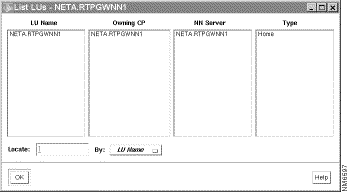 U List Window
U List Window
The LU List window displays a row of information for each independent or dependent LU. Each row contains the following items:
To save a custom topology for later use, select File>Save As from menu bar and enter a name for the topology. When you re-open the topology file, you will see an exact representation of the saved map. Saving is also done automatically when you switch views or end the application normally.
If the CiscoWorks Blue SNA View product is also installed, you can use the SNA View Task Manager window to display VTAM and MVS messages and to issue mainframe commands. The SNA View Task Manager window is described in the CiscoWorks Blue SNA View Workstation Installation and User Guide. To start the SNA View Task Manager, select Tools>SNA View Task Mgr from the menu bar.
To terminate the APPN application, select File>Exit from the menu bar.
The colors and symbols on the APPN map have the following meanings:
Table 7-2 identifies the icons displayed on an APPN map
| Icon | Description |
|---|---|
|
Known APPN network node. |
| Managed APPN network node; the check mark above the icon shows that the NN is managed by CiscoWorks Blue Maps. |
| APPN network topology agent in a global view. Focus node in an adjacent node or ports and links view. |
|
APPN end node. |
|
APPN LEN node.
|
| Port on an APPN network node. The letter in the circle indicates the port type:
|
|
Unknown or unmanaged node. |
|
Host node (VTAM mainframe). |
|
Virtual routing node (connection network). |
![]()
![]()
![]()
![]()
![]()
![]()
![]()
![]()
Posted: Thu Aug 19 11:02:56 PDT 1999
Copyright 1989-1999©Cisco Systems Inc.